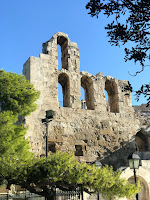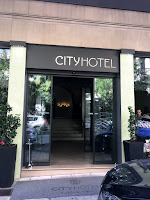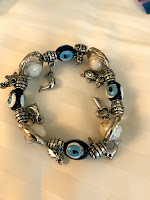Athens in a day
Get ready, lots of info today! We are getting to know this bus really well!
First the Parthenon which is dedicated to the Goddess of Wisdom, Athena. She is said to have brought Olive trees to Greece. We learned the other day that an Acropolis is a high point in a city. So the Parthenon is a building at the acropolis in Greece. There is a concert hall, the Herodian, that is still in use and seats 5000. The arches mark the concert hall.
This photo is particularly accurate because it shows the 11 goddesses in front of the Parthenon which is dedicated to the 12th and last Goddess, Athena.
The Parthenon is important mostly because it is still standing. At the time builders were looking for a geometrical foundation that would withstand earthquakes, so the Parthenon is an example of an architectural design that shows the victory of man over nature. (In Michigan, we can’t even build a road that withstands one winter.) Today, the challenge is withstanding air pollution which will eventually turn the limestone areas to chalk dust.
This area was a fortress against the Persians. This picture shows the gateway which had a large door which included iron. Many of the steps that we climbed were original from the 5th century BC. They were uneven and slippery stones, and we were trying to imagine families running up barefoot or in sandals trying to get through the gates before they closed. (Drop that toy and get inside the gates!!!)
Then we saw the Olympic Stadium. The first modern Olympics were held in 1896. The second time in Greece in 1906 and then not again until 2004. A new stadium was built in northern Athens that seated 90,000 people, which was used for opening and closing ceremonies of the 2004 games. The stadium was used for the marathon and archery.
We had a stop for lunch in the Plaka area where there were many shops and restaurants.
We then traveled in our bus through several seaside towns to Cape Sounio, where we saw the Temple of Poseidon, God of the Sea. These photos cannot do justice to the beauty of this area.

We had a free dinner tonite. Some of the Goddesses went back to the shopping area. Sheila, Michele, Jen, and the Laura’s went to the Cave of the Acropolis and mingled with families dining there.. Michele has promised a video of Laura dancing with the locals.... Some of our group went across the street to the Onassis building for dinner at the rooftop restaurant, Hytra, which has a Michelin Star. Lori wondered (out loud!) whether that meant the Michelin Man would be serving our cocktails.... Lori, Deb, Cindy and I kept Kyle (EF Tours employee traveling with us) entertained by giving him the benefit of our years of marital experience in the form of advice for the future, even though he is not even engaged yet. Poor Kyle.
But I digress. The food was amazing but the view was even better.


This photo is particularly accurate because it shows the 11 goddesses in front of the Parthenon which is dedicated to the 12th and last Goddess, Athena.
The smaller temple near the Parthenon is also dedicated to Athena and contains the maiden statues. It is called the Erecthium. It is special because it was the first time that statues of women were included in a Greek monument. In the 6th century BC women had no status. In the 5th century a sculptor created the first statues of women, so women were struggling for a quality even back then. At the time Greek comedies and tragedies depicted the political climate and a comedy was written showing women striking back by withholding sex. Not surprisingly it was effective.
The Parthenon is important mostly because it is still standing. At the time builders were looking for a geometrical foundation that would withstand earthquakes, so the Parthenon is an example of an architectural design that shows the victory of man over nature. (In Michigan, we can’t even build a road that withstands one winter.) Today, the challenge is withstanding air pollution which will eventually turn the limestone areas to chalk dust.
This area was a fortress against the Persians. This picture shows the gateway which had a large door which included iron. Many of the steps that we climbed were original from the 5th century BC. They were uneven and slippery stones, and we were trying to imagine families running up barefoot or in sandals trying to get through the gates before they closed. (Drop that toy and get inside the gates!!!)
Then we saw the Olympic Stadium. The first modern Olympics were held in 1896. The second time in Greece in 1906 and then not again until 2004. A new stadium was built in northern Athens that seated 90,000 people, which was used for opening and closing ceremonies of the 2004 games. The stadium was used for the marathon and archery.
We had a stop for lunch in the Plaka area where there were many shops and restaurants.
We then traveled in our bus through several seaside towns to Cape Sounio, where we saw the Temple of Poseidon, God of the Sea. These photos cannot do justice to the beauty of this area.

We had a free dinner tonite. Some of the Goddesses went back to the shopping area. Sheila, Michele, Jen, and the Laura’s went to the Cave of the Acropolis and mingled with families dining there.. Michele has promised a video of Laura dancing with the locals.... Some of our group went across the street to the Onassis building for dinner at the rooftop restaurant, Hytra, which has a Michelin Star. Lori wondered (out loud!) whether that meant the Michelin Man would be serving our cocktails.... Lori, Deb, Cindy and I kept Kyle (EF Tours employee traveling with us) entertained by giving him the benefit of our years of marital experience in the form of advice for the future, even though he is not even engaged yet. Poor Kyle.
But I digress. The food was amazing but the view was even better.


Now to bed. We are up at 5:30 tomorrow for a flight to Crete. Calle Nichta. (good night).















Comments
Post a Comment